Ulistac Natural Area
Ulistac Natural Area
On Saturday D. and I visited the Ulistac Natural Area in Santa Clara. Opened to the public 10 years ago, it was Santa Clara's last 40 acres of open space preserved from development. It was originally inhabited by the Ohlone Indians, then by the Spanish missionaries, and later used as a pear orchard and a golf course. Once abandoned by the developer, plants began to grow back and wildlife began to return. Volunteers are now helping to restore many different habitats that were once readily found in the Santa Clara area, including oak savannah, live oak woodland, deciduous oak woodland, and grassland. So, on a breezy autumn afternoon we went to check it out, and I took these pics.
We're here.

Oh Hai! We open the trail map box to find a couple of wasp nests and a live wasp (and some trash, but no maps). Surprise!

Masses of California aster seed head floofs at the trailhead.
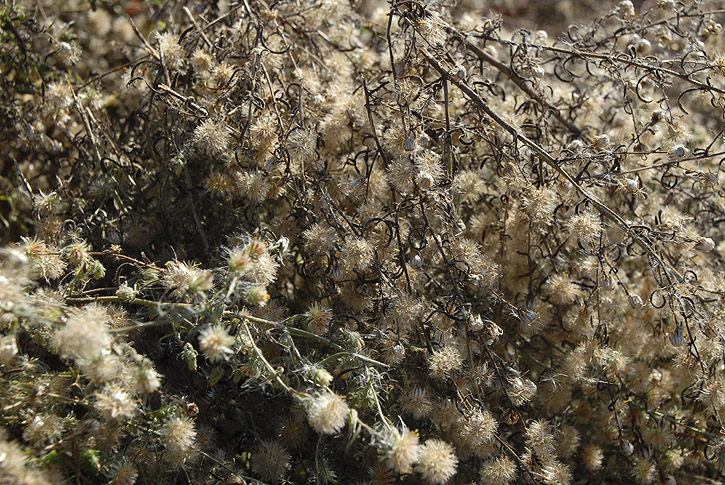
What's in a name? This edumacational plaque explains what Ulistac means.

Lovely autumn foliage awaits us as we start out on the path.

An example of a sycamore woodland habitat, more open than is typical.
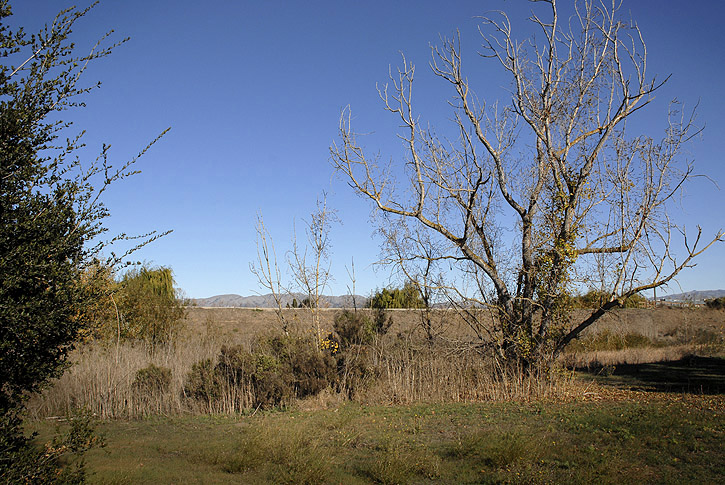
One of the many non-native blue gums, towering 150' tall.

Examples of a wetland habitat, full of narrow-leaved cattails. This wetland was once a bend in the Guadalupe River. The river was channelized in 1963 to control flooding, and its course was straightened so that it no longer flows through this part of the park. This lowland area developed into the current wetland habitat. The freshwater marsh is choked with cattails and tule rushes, obscuring any open water.
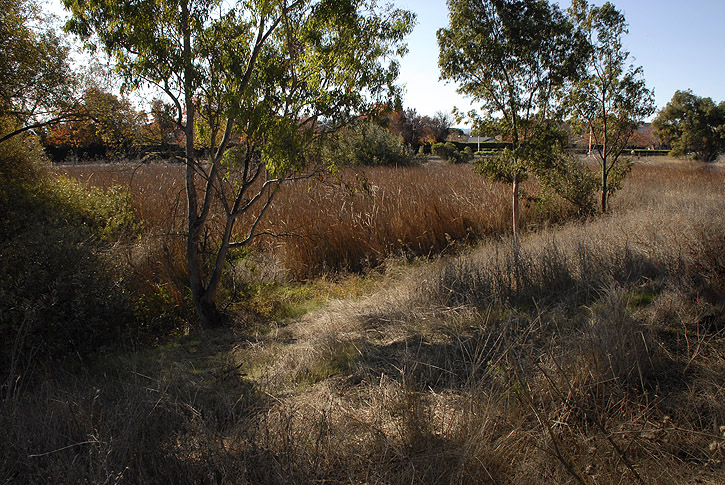

Hawksbeard.

Another huge blue gum tree. They are a relic from the ranching days when they were planted as a fast-growing windbreak.

Arroyo willows line the edge of the cattail bed in the wetland. On the right is the levee forming the west bank of the Guadalupe River.

Up on the levee, looking down on the swale.


A cluster of backlit cottonwood leaves glows against the dull tawny tones of dead cattails in the swale.

Cottonwoods turn a beautiful yellow in autumn.

Fennel seed heads droop down, heavy with seeds.

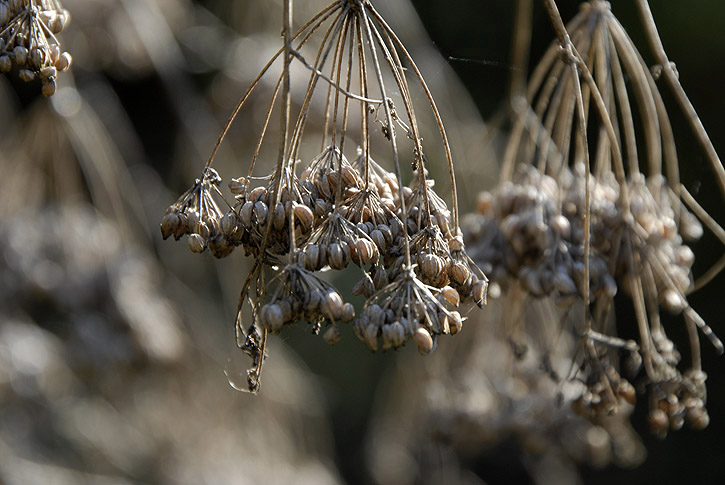
Coyote brush is another plant with floofy seeds that go sailing far and wide on the slightest breath of wind.

The path goes past brilliant yellow cottonwoods near the riparian habitat area.


There is a busy bee in this hawksbeard blossom. One of her pollen baskets is quite full (left hind leg).
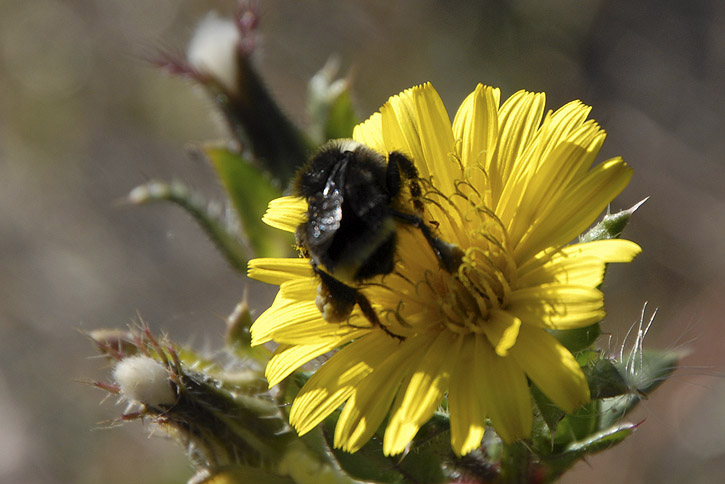
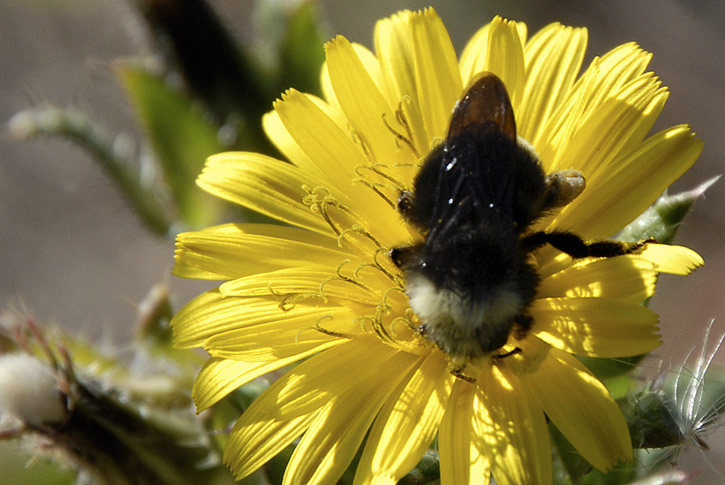
A nest box, one of at least 13 in the area (judging by the number on the bottom of the box).

It's a sycamore sky.

More coyote brush floofs.

I think they have a sow thistle problem here.

Another look back down the path.

The feathery foliage of California sagebrush.

The Carmel ceanothus has a dark blue blossom.

This lovely scene is brought to you by the letter E.

Sticky monkeyflower likes to grow in shady, moist locations.

Snowberries are high in fat and are an important food source for birds during the winter.
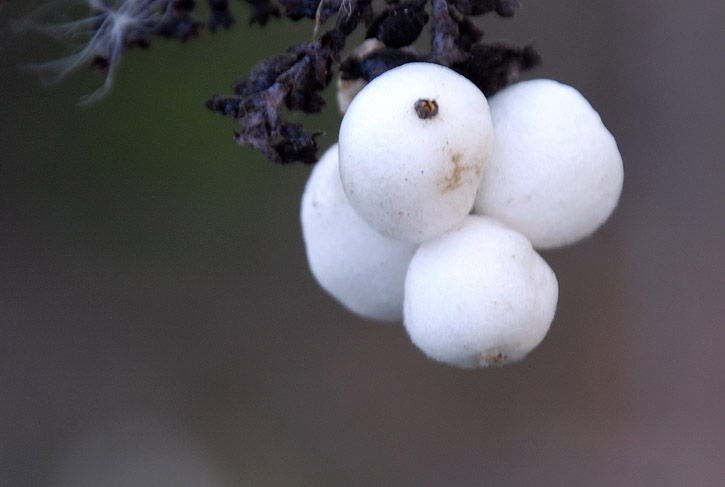
Sty on rail?
(It looks like a vehicle backed into it and bent it.)

This huge bracket fungus was growing out of the base of a dead blue gum tree.


Milk thistle seeds are good for the liver, but the plant is not native to California and most nature preserves try to eradicate it since it crowds out native species.

Thistle pods littering the ground near the riparian habitat area offer their soft floofy seeds to the wind.


A look back toward the sycamore woodland area.

The oak woodland area. In the early ranching days there was a small cultivated area of crops here. The soil must have been very rich since it would have been on the banks of the original Guadalupe River, getting replenished with fresh nutrients after every flood.

These dead oak leaves remind me of contorted, grasping hands.

I don't think they want us to go into the Fairway Glen Storm Station.
The pumping station shares some of the land with the natural area and helps with Guadalupe River flood control.

We take a look at the butterfly and hummingbird garden, with 700 California native shrubs. Here is California fuchsia, also known as hummingbird trumpet, and it is easy to see why.

Cleveland sage.


Hips of the California wild rose.

The California aster is found in grasslands and salt marshes.


This coyote brush is impressively floofy.

This earthstar fungus is related to the puffball. It releases its reproductive spores explosively.

An autumn oak.




This hawksbeard bloom seems to rival the sun with its brilliance.

This pine succumbed to a fire that swept through the area many years ago.

On our way back we pass a small field full of jimsonweed. Also known as devil's trumpet, devil's weed, thorn apple, tolguacha, Jamestown weed, stinkweed, locoweed, datura, pricklyburr, devil's cucumber, Hell's Bells and moonflower, jimsonweed is a common weed in the nightshade family, and all parts of it are toxic. It bears formidable-looking spiny burrs packed with small black seeds.





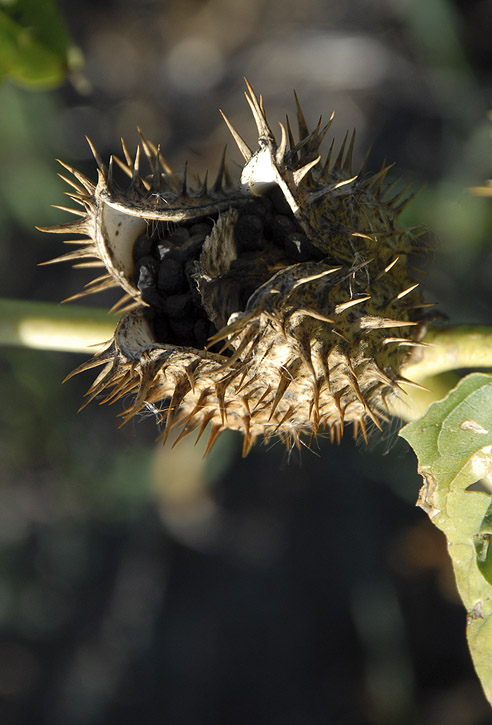
One last look at beautiful autumn gold before heading home.

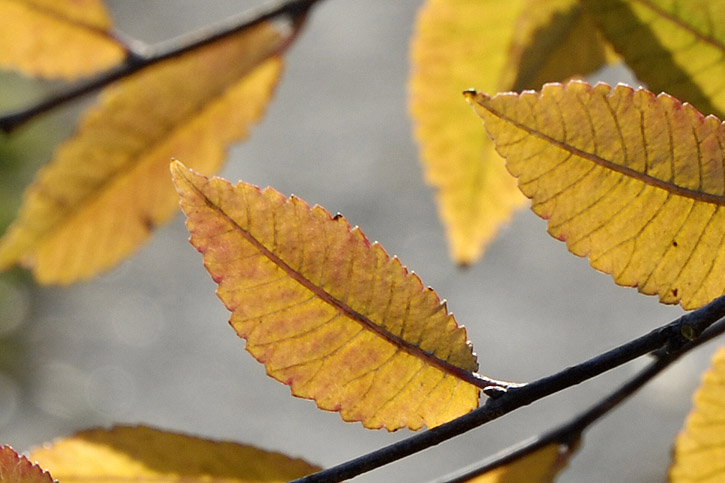
.
On Saturday D. and I visited the Ulistac Natural Area in Santa Clara. Opened to the public 10 years ago, it was Santa Clara's last 40 acres of open space preserved from development. It was originally inhabited by the Ohlone Indians, then by the Spanish missionaries, and later used as a pear orchard and a golf course. Once abandoned by the developer, plants began to grow back and wildlife began to return. Volunteers are now helping to restore many different habitats that were once readily found in the Santa Clara area, including oak savannah, live oak woodland, deciduous oak woodland, and grassland. So, on a breezy autumn afternoon we went to check it out, and I took these pics.
We're here.

Oh Hai! We open the trail map box to find a couple of wasp nests and a live wasp (and some trash, but no maps). Surprise!

Masses of California aster seed head floofs at the trailhead.

What's in a name? This edumacational plaque explains what Ulistac means.

Lovely autumn foliage awaits us as we start out on the path.

An example of a sycamore woodland habitat, more open than is typical.

One of the many non-native blue gums, towering 150' tall.

Examples of a wetland habitat, full of narrow-leaved cattails. This wetland was once a bend in the Guadalupe River. The river was channelized in 1963 to control flooding, and its course was straightened so that it no longer flows through this part of the park. This lowland area developed into the current wetland habitat. The freshwater marsh is choked with cattails and tule rushes, obscuring any open water.


Hawksbeard.

Another huge blue gum tree. They are a relic from the ranching days when they were planted as a fast-growing windbreak.

Arroyo willows line the edge of the cattail bed in the wetland. On the right is the levee forming the west bank of the Guadalupe River.

Up on the levee, looking down on the swale.


A cluster of backlit cottonwood leaves glows against the dull tawny tones of dead cattails in the swale.

Cottonwoods turn a beautiful yellow in autumn.

Fennel seed heads droop down, heavy with seeds.


Coyote brush is another plant with floofy seeds that go sailing far and wide on the slightest breath of wind.

The path goes past brilliant yellow cottonwoods near the riparian habitat area.


There is a busy bee in this hawksbeard blossom. One of her pollen baskets is quite full (left hind leg).


A nest box, one of at least 13 in the area (judging by the number on the bottom of the box).

It's a sycamore sky.

More coyote brush floofs.

I think they have a sow thistle problem here.


Another look back down the path.

The feathery foliage of California sagebrush.

The Carmel ceanothus has a dark blue blossom.

This lovely scene is brought to you by the letter E.


Sticky monkeyflower likes to grow in shady, moist locations.

Snowberries are high in fat and are an important food source for birds during the winter.

Sty on rail?

(It looks like a vehicle backed into it and bent it.)

This huge bracket fungus was growing out of the base of a dead blue gum tree.


Milk thistle seeds are good for the liver, but the plant is not native to California and most nature preserves try to eradicate it since it crowds out native species.

Thistle pods littering the ground near the riparian habitat area offer their soft floofy seeds to the wind.


A look back toward the sycamore woodland area.

The oak woodland area. In the early ranching days there was a small cultivated area of crops here. The soil must have been very rich since it would have been on the banks of the original Guadalupe River, getting replenished with fresh nutrients after every flood.

These dead oak leaves remind me of contorted, grasping hands.

I don't think they want us to go into the Fairway Glen Storm Station.

The pumping station shares some of the land with the natural area and helps with Guadalupe River flood control.

We take a look at the butterfly and hummingbird garden, with 700 California native shrubs. Here is California fuchsia, also known as hummingbird trumpet, and it is easy to see why.

Cleveland sage.


Hips of the California wild rose.

The California aster is found in grasslands and salt marshes.


This coyote brush is impressively floofy.

This earthstar fungus is related to the puffball. It releases its reproductive spores explosively.

An autumn oak.




This hawksbeard bloom seems to rival the sun with its brilliance.

This pine succumbed to a fire that swept through the area many years ago.

On our way back we pass a small field full of jimsonweed. Also known as devil's trumpet, devil's weed, thorn apple, tolguacha, Jamestown weed, stinkweed, locoweed, datura, pricklyburr, devil's cucumber, Hell's Bells and moonflower, jimsonweed is a common weed in the nightshade family, and all parts of it are toxic. It bears formidable-looking spiny burrs packed with small black seeds.






One last look at beautiful autumn gold before heading home.


.